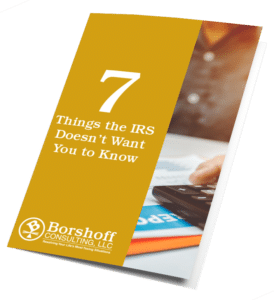Tax credits are tax breaks offered by the IRS that allow you to reduce your tax liability by the amount of the tax credit. Tax deductions reduce your taxable income, but they do not allow you to have more of a tax refund or anything like that.
Basically, deductions just reduce the income you are taxed on when filing your annual tax return. Credits, on the other hand, give you a much greater tax break because they directly reduce the amount of your tax bill. Some are even refundable, meaning you could end up with a tax refund for any overage that you didn’t use.
When deciding whether or not to take certain tax credits, it’s a good idea to meet with a qualified tax representative, such as a tax accountant or CPA. Tax professionals speak the language and better understand what forms and schedules are required for you to take the tax credit.
Qualified tax consultants also can represent you in the event of an audit and can help you determine which tax breaks are most beneficial for your tax situation. This is, after all, what they do for a living, so find someone you trust who can help you file your taxes in a correct and favorable way.
Are you new to the subject of tax credits and want to learn more about them? In this article, we’ll examine what a tax credit is, the differences between tax deductions and credits, what refundable credits are, how credits work on your tax return, and a summary of the more popular tax credits that are out there.
What is a tax credit?
A tax credit is an amount, as determined by the IRS (Internal Revenue Service) that taxpayers get to subtract from their tax bill. All tax credits are either refundable or non-refundable; some are even partially refundable. If a credit is refundable, the difference between the amount of the credit and the amount of one’s tax bill may be received as a tax refund to the taxpayer.
Example: If your tax credit is refundable and worth $3,000, and your tax bill is $2,000, you may be able to receive a tax refund in the amount of $1,000 ($3,000 tax credit less your tax bill of $2,000). This is why tax credits are more popular than tax deductions.
What is the difference between tax credits and tax deductions?
The main difference between tax credits and tax deductions is that deductions are made to reduce your taxable income. Your taxable income is what you pay taxes on, so the lower, the better. Tax deductions, thus, do reduce the amount of taxes you will owe because they reduce the income you are to pay taxes on in an indirect way.
Tax credits, on the other hand, directly reduce the amount of taxes you owe. If you are able to claim a tax credit, your tax bill will be reduced by the amount of the credit. Some credits are refundable, others are non-refundable, and there are some that are partially refundable.
If you have a choice between a tax deduction and credit, it’s advisable that you compute your tax bill, doing it both ways. Calculate it once with you taking the tax deduction, and then see what the total bill will be. After that, calculate it as if you are able to take the tax credit, taking into account whether the credit is refundable, partially refundable, or not refundable at all.
If you are not eligible for a tax deduction or credit, you should not try to claim them. If the IRS discovers you incorrectly took tax credits, there may be penalties, interest, or further consequences. If you anticipate that a tax audit is coming your way, it’s advisable that you seek the counsel of a trusted tax accountant who can represent you in the event of a tax audit.
As a side note, if you decide to enlist the help of a tax accountant, it’s a good idea to prepare for your tax consultation in advance, having all of the necessary paperwork ready to share. Make sure you are smart about who you hire to represent your tax interests; this person will be representing you to the IRS in the tax returns he or she prepares for you.
What are refundable tax credits?
Refundable tax credits may give you a tax refund if the amount of the credit is greater than the amount of your tax bill on your annual tax return. Partially refundable credits allow a specific portion of the tax credit to be treated as refundable, but this amount is not equal to the amount of the actual credit. They are still beneficial to take and some carryover to future years.
How does a tax credit work?
A tax credit directly reduces your tax bill by the amount of the tax credit. If the tax credit is refundable, you may be entitled to the amount of the difference between the tax credit amount and the amount of your tax liability (tax bill). For partially refundable tax credits, you may still be entitled to a tax refund, but it will be at a reduced amount, depending on the terms of the tax credit.
What are the most popular tax credits?
1. The American Opportunity Tax Credit
The American Opportunity Tax Credit (AOTC) allows taxpayers who are students or their parents the chance to reduce the cost of going to college. The IRS states that the AOTC is a partially refundable tax credit for qualified educational expenses paid by or for an eligible student.
A student could lower his or her tax bill by up to $2,500 if that much was paid by him or her for educational expenses in the previous year.
This credit allows you the opportunity to claim all of the first $2,000 that was spent on qualified college expenses, such as books, supplies, school fees, and tuition. It does not cover living expenses like room and board or transportation costs. However, you are able to take 25% of the next $2,000, for a total of $2,500.
Complete IRS Form 8863: Education Credits to claim this credit and attach the completed form to your tax return. Make sure you inform whoever does your taxes that you want to claim the AOTC.
2. The Adoption Tax Credit
The Adoption Tax Credit is a credit you may be able to take for qualified adoption expenses. The credit is non-refundable, but you can carry forward, for up to five years, any tax credit amount in excess of your tax liability.
The eligible adoptive parent must have qualified adoption expenses, as determined by the IRS. The maximum amount for the tax year 2019 is $14,080. For the tax year 2020, the amount has been increased to $14,300. This amount is per child and must be claimed when filing your annual tax return.
To claim the Adoption Tax Credit, you must complete IRS Form 8839: Qualified Adoption Expenses, and attach it to your annual tax return. If you are hiring a tax consultant, please discuss with them your desire to claim this tax credit and determine what information they need from you.
3. The Additional Child Tax Credit
The Additional Child Tax Credit (ACTC) is a refundable tax credit for those who are unable to get the full amount out of the Child Tax Credit. If you receive less than the full amount of the Child Tax Credit, you may be eligible. However, this only applies to taxpayers who claimed or will claim the Child Tax Credit.
For those who claim the Credit for Other Dependents (ODC) and not the Child Tax Credit, the Additional Child Tax Credit is not an option. If you file IRS Form 2555: Foreign Earned Income (or IRS Form 2555-EZ), you also are not eligible for the Additional Child Tax Credit.
This tax credit is worth up to 15% of your taxable income over $2,500. The maximum amount that you can reduce your tax bill and possibly receive a refund is $2,500. That is the refundable portion of the Child Tax Credit.
To claim this tax credit, use the Child Tax Credit and Credit for Other Dependents Worksheet. You will also need to use IRS Schedule 8812: Additional Child Tax Credit to determine if you are eligible, and attach this form to your annual tax return, or give it to your tax preparer.
4. The Child Tax Credit
The Child Tax Credit (CTC) is a great credit created for parents with qualifying children. The credit is worth up to $2,000 per child with a refundable portion worth up to $1,400 for the tax year of 2020, but this amount depends on your income.
Certain requirements must be met to claim this tax credit. To learn more about the requirements associated with the Child Tax Credit, check out IRS Publication 972: Child Tax Credit.
The Child Tax Credit is worth as much as $2,000 per qualifying child under the age of 17. If you have several children under the age of 17, the Child Tax Credit could prove to be quite valuable to you.
Keep in mind that you must have a qualifying child to claim this credit. Briefly, to be considered as a qualifying child, he or she must meet six tests: (1) Age, (2) Relationship, (3) Support, (4) Dependent, (5) Citizenship, and (6) Residence.
5. The Child and Dependent Care Tax Credit
The Child and Dependent Care Credit is a credit created for parents who incur childcare expenses while they are working or actively seeking employment. The qualifying child under care must be under the age of 13 years.
For children of divorced or separated parents, IRS Publication 503: Child and Dependent Care Expenses will be useful. There are circumstances in which a spouse or disabled individual can be counted as the person needing the care while the taxpayer seeks work or goes to his or her place of employment.
The Child and Dependent Care Tax Credit is a percentage of your qualifying expenses up to $3,000 for one individual or $6,000 for more than one individual. The way it is set up is so you cannot get a credit of more than $6,000 if you are married and filing a joint tax return.
The percentage of the Child and Dependent Care Tax Credit ranges from 20% to 35% of the amount you spent on care for the child or dependent up to the $3,000 (single) or $6,000 (married) limits. The credit is limited by your earned income and that of your spouse if filing a joint return.
To claim this tax credit, complete IRS Form 2441: Child and Dependent Care Expenses. Attach this form to your annual tax return or give it to your tax consultant.
6. The Tax Credit for the Elderly or Disabled
The Tax Credit for the Elderly or Disabled is for taxpayers over the age of 64 or who are retired due to a permanent and total disability. This tax credit is worth between $3,750 and $7,500, depending on your specific circumstances.
The Tax Credit for the Elderly or Disabled is 15% of the “initial” amount, less the total of all nontaxable Social Security payments, certain nontaxable pensions, disability benefits, or annuities. The initial amount, as referred here, is the lesser of your taxable disability income or the set income limitations, as determined by the IRS each year.
To determine the amount of the credit, you must add in one-half of your adjusted gross income less your income limitation amount for the year.
To claim this credit, you must fill out two additional forms when you complete your annual tax return or have a qualified tax professional do this for you. One is Schedule R: Credit for the Elderly or the Disabled. The other tax form you will need is Schedule 3: Additional Credits and Payments.
7. The Tax Credit for Other Dependents
The Tax Credit for Other Dependents was created for taxpayers with dependents who do not qualify for the Child Tax Credit. Taxpayers are allowed to claim $500 per qualifying dependent.
This maximum tax credit amount cannot be more than $500 per dependent per the tax year and may be reduced if your taxable income amount is less than the total of both credits – the Child Tax Credit and Credit for Other Dependents.
Children older than 17 years old, elderly dependents who rely on the taxpayer for their care, and other qualifying dependents are considered to be eligible dependents for this credit, but it’s always a good idea to work with a tax consultant who will have the latest information.
You must file IRS Form 1040 or IRS Form 1040-NR when you file your tax return and, if applicable, must file IRS Form 8862: Information to Claim Certain Credits After Disallowance, and you must have a Taxpayer Identification Number (TIN).
8. The Earned Income Tax Credit
The Earned Income Tax Credit is refundable and was created for taxpayers with low to moderate-income. Basically, the more children you have, the greater this credit will be for you. You can claim this credit if you are childless, but you will not receive the same tax breaks, and the requirements for eligibility are stricter.
If you are unsure if you qualify for this credit, check out IRS Publication 5334: Do I Qualify for the EITC?
If you only have one qualifying child, the maximum credit you may receive is $3,584. If you have two qualifying children, the maximum credit you may be eligible for is $5,920. Typically, families with three or more children may receive the maximum amount of the credit, which is the $6,660.
For workers who do not have any qualifying children, the maximum amount they may receive for the EITC is $538. Also, for these taxpayers, the phaseout amount occurs at much lower income amounts.
For the tax year 2020, the income requirement for taxpayers with no children is $15,820 ($21,710 for married individuals). If you have only one child, the income requirements jump to $41,756 ($47,646 for married individuals), and for three children, it goes to $47,440 ($53,330 for married individuals). Finally, those who have three or more children have an income requirement of $50,954 ($56,844 for married individuals).
Note that “married individuals” refer to those who are married and filing a joint tax return.
You must file IRS Schedule EIC: Earned Income Tax Credit listing your children if you do have a qualifying child or children. Attach this schedule to your IRS Form 1040 or 1040 SR.
9. The Health Coverage Tax Credit & Premium Tax Credit
The Health Coverage Tax Credit is a federal tax credit offered by the IRS for eligible taxpayers to offset the cost of their monthly health care insurance payments. This credit allows you to have 72.5% of the taxpayer’s qualified health insurance coverage premiums to be paid directly to the health plan administrator on a monthly basis.
This tax credit was created to reduce the amount of out of pocket payments taxpayers incur for monthly premiums. It is generally for taxpayers at least 55 and up to 65 years of age who are receiving benefits from the Pension Benefit Guaranty Corporation (PBGC) or other qualified plans. A qualifying family member may also be eligible.
To receive reimbursement after paying through a qualified program, complete IRS Form 14095: HCTC Reimbursement Request. If you do not take advantage of the Health Coverage Tax Credit Advance Monthly Program, which gives you the healthcare reimbursements for insurance purposes, you can fill out a form and return it to the IRS annually.
To do this, complete IRS Form 8885: Health Coverage Tax Credit, and attach the form to your annual tax return, or give it to the person who will be preparing your tax return, letting them know what you want to claim on your taxes.
If you have a healthcare plan through a Health Insurance Marketplace, you are not qualified for the Health Coverage Tax Credit. However, you may be eligible for the Premium Tax Credit (PTC).
The Premium Tax Credit is a refundable credit that helps eligible taxpayers and families pay for their health insurance premiums through the Health Insurance Marketplace.
10. The Lifetime Learning Tax Credit
The Lifetime Learning Credit (LLC) is another education tax break that helps with the cost of education.
LLC is an education tax credit for qualified tuition and education-related expenses paid for eligible students who are enrolled at an eligible educational institution. The qualified education-related expenses eligible for this credit do not include transportation costs or living expenses.
This credit can help pay for undergraduate, graduate, and professional degree courses. This includes courses taken to gain or improve upon job-related skills. Unlike the American Opportunity Tax Credit, there’s no limit on the number of years you can claim the LLC.
The Lifetime Learning Tax Credit is worth 20% of the first $10,000 of qualified education expenses or a maximum of $2,000 per annual tax return.
Like the AOTC, to claim this credit, the taxpayer is required to have Form 1098-T, Tuition Statement, from an eligible educational institution, domestic or foreign. Students should receive this form from their school by January 31. Use this statement to figure out the amount of Lifetime Learning Tax Credit.
Use IRS Form 8863: Education Credits to claim this credit; attach the completed form to your annual tax return or give it to your tax preparer.
Conclusion
Are you looking to file your taxes with tax deductions or credits? Are you ready to file your taxes, or are you looking for someone to assist you in filing your annual tax return? At Borshoff Consulting, tax law is the language we speak. We understand and keep up with the latest laws, rules, and regulations that you need to know to file your tax return the right way.
If you are looking for a tax consultation with a qualified tax representative, please contact us today. We are more than qualified and excited to help you get the most out of your taxes. We can also represent you in the case of an audit if you anticipate one coming your way. Please contact us if you need a tax professional to help you with an audit.
Did you know that Borshoff Consulting also handles tax relief, business consultations, and more? It’s true that we are capable of helping taxpayers and small businesses with a variety of issues, offering counsel and solutions to problems.
Feel free to fill out the form below to schedule a free consultation, and we will see what we can do to help you. If we don’t have the information you need, we will work diligently to point you in the right direction. You can trust Indiana’s Tax Expert!!





